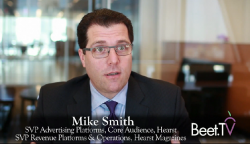
From its first origins in 1887 as owner of the San Francisco Examiner, Hearst has certainly changed over the years.
Back then, the company had just one title. Now focused on magazines, websites and video, the publisher is more interest in applying a diverse range of mechanisms to its ad sales operation.
Hearst ad platforms SVP Mike Smith tells Beet.TV the company uses five methods of selling digital ads:
- direct
- private exchange
- public exchange
- programamtic direct
- header bidding
“The mix is a healthy mix,” Smith says. “The part that’s growing is the programmatic direct, or what the IAB calls an automated guarantee. It’s buyers that traditionally have bought direct – we essentially automate their buying process and make it more efficient to buy our media that way.”
These days, there is a glut of ad-tech vendors all competing for the attention of publishers like Hearst, promising to make their sales more efficient and profitable. Whilst some customers like to cut down on the number of extra parties with hands on their money, Hearst prefers to work with many.
“We like to work with a lot of companies,” Smith adds. “Different companies specialise in mobile versus video, even display on desktop, different creative formats.”
He counts Google, AppNexus, Rubicon, OpenX and CPX Interactive amongst the key partners for Hearst.
This video part of a series about the state of programmatic advertising sponsored by OpenX. Please find other videos from the series here.


























